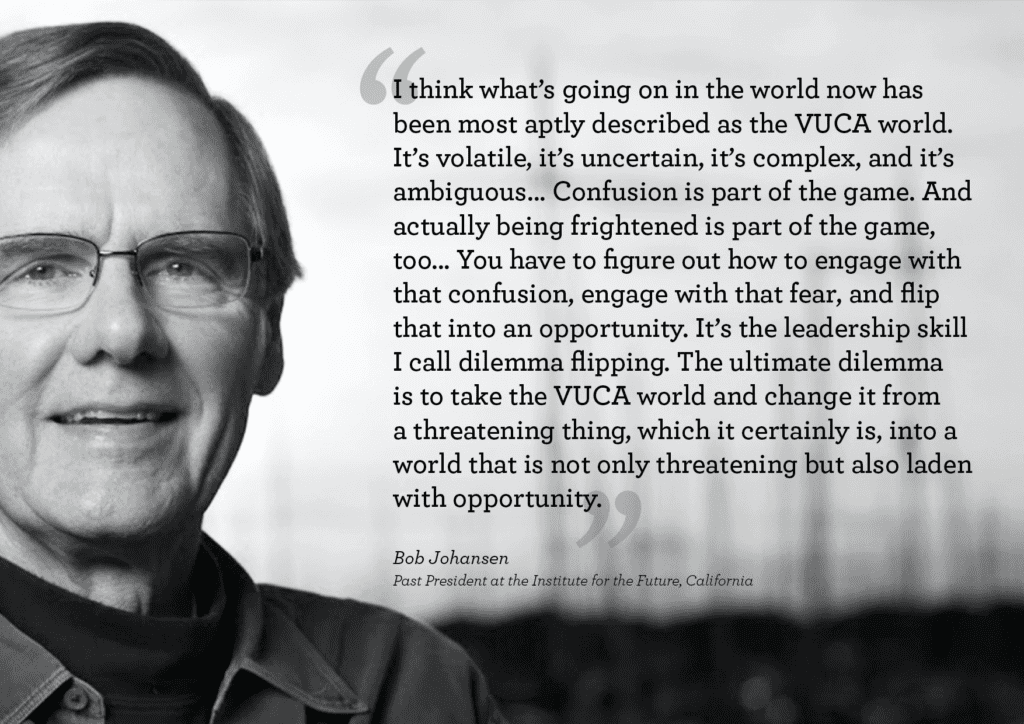Change management has a bad reputation. And rightly so, since it quite often fails. Again and again, new methods and instruments are developed and applied to deal with this. Why does change management fail nonetheless? The answer to this is that something essential is missing, especially when dealing with the challenges we face in the 21st century. We believe that there are three main things you have to consider if you want to deploy a change program successfully:
- First, involve shifters who actively transform the old identity of an organization into a new meaningful future. For making change happen, shifters are key.
- Second, be aware that humans are opposed to change because our brain is hardwired to resist change (Theory of the Predictive Mind). There is no way around meeting this challenge head-on.
- And third, change is complex. Therefore, linear management based on “prediction and control” won’t work. Instead, we need to initiate change “from the future” and “learn from the future as it emerges”, rather than simply trying to forecast it.
Making change in a VUCA world
What are the foundational conditions that today’s change programs are built upon? In what kind of environment do they have to succeed? And how are they different from environments in which the old-fashioned change programs have been developed?
Just think of how the world has changed. Think of all the surprising turns of events, economic uncertainty, and that it has become increasingly difficult to make sense of what is happening all over our planet. All of this has a name: VUCA. We live in a VUCA world, that is, a volatile, uncertain, complex, and ambiguous world. And this raises the question of how we can change our organizations desirably in such a business environment. In other words: how should your business look in the future, given that we don’t know how the world will change, what global developments mean, and so whether our change programs will ultimately come to fruition?
Traditional recipes will not do this time around. As we cannot predict the course of events in a linear fashion, we have to fundamentally rethink how we can lead change into a desirable direction. Let us be clear. What doesn’t work is to simply to have a plan that shows, step by step, how the change will be brought about. To do so is to work against the very basis of our VUCA world.
What is the alternative then? You might have felt that the term VUCA has a negative connotation. Volatility, uncertainty, complexity, and ambiguity seem to work against us. They need to be avoided and actively reduced. However, we can see things differently. There is great potential to be found in such a world. Therefore, an alternative to orthodox change management and leadership should not simply avoid these challenges, but take advantage of them and turn them into opportunities. We want to introduce you to three essential insights into how we can meet the potentials of our VUCA world to make truly radical change happen.

Shifters instead of change managers
Think of who is usually in charge of change projects. Oftentimes, they are lead and executed by high-potentials who are either educated and experienced in a particular domain (for instance, digitization or product and service development). Their projects are mostly predefined and have clear-cut goals. So their task is to simply carry out the project plan – the more linear the better.
However, change projects require a wide range of different leadership skills. Many of them are not held by a typical project manager. Rather, they can be found in so-called “shifters”. Shifters are people who actively transform an organization’s old identity into a meaningful new future. They change an organization’s deeply rooted habits, stirring them up, and establishing new ones. To cultivate these skills and actively engage shifters should be a key demand of any change project – especially in the context of our VUCA world.
So who are they? Where can you find those shifters?
Who are shifters?
Shifters are a highly diverse group of people, and they can have different areas of expertise. What unites them, however, are the following skills:
- They have a thorough understanding of an organization’s history and its future orientation.
- They are empathic and good at developing and facilitating the relevant skills of employees. They are excellent communicators and have a strong and holistic understanding of organizational transformation.
- Shifters are well embedded in organizations and have strong networks. Furthermore, they enjoy a good reputation among their peers.
What do shifters do?
As stated above, shifters enable the transition from old organizational mindsets, processes, and practices into new ones – all this to enable the future direction of the organization. They proactively transform the organization’s identity for a digital world. This a most challenging task, as old mindsets and habits are hard to unlearn, and radically new ones likewise hard to build up. Even more so, as people are neurobiologically resistant to change, as we will see in the remainder of this blog post.
So how do shifters make their magic happen? How do they bring about change?
- They continuously focus on transforming the old into the new – and constantly foster confidence to live up to the challenge. They “ease the pain” of having to face uncertainty and ambiguity, persistently motivating, and engaging employees and stakeholders.
- They also serve as a bridge between strategic thinkers who deal with abstract concepts – and those who have to deal with those concepts hands-on. Sifters achieve this by translating such concepts. They turn them into relatable stories and understandable ideas. They turn visions into action.
- Shifters connect people. They bring together pioneers and sustainers and thereby create an overarching community of practice that can make change happen.
Considering this, a typical shifter seems to be a zero-risk asset for any change project. And indeed, there are many positives to have them in a change team. But even though the positives outweigh the negatives, we want to consider both their strengths and weaknesses.
Subscribe to Our Newsletter
Keep your innovative edge with more stories like this and additional reading tips, muses, and project updates.
Strengths and weaknesses of shifters
So what are the strengths of a typical shifter?
- Shifters do not lose themselves in detail. Rather, they see the “bigger picture” and think “holistically”. However, they can also translate the bigger picture into concrete action.
- Shifters are not intellectually stubborn. They can look at things from radically different perspectives and reflect on their own assumptions.
- Rather than avoid conflict, they seek it out – they are “mining for conflict” and harvest its constructive powers.
- Moreover, they are okay with ceding the spotlight to others. They help others shine and accept being the second in line.
Yet, we must also take into account the possible weaknesses of shifters.
- Most inexperienced shifters tend to be overly reliant on ready-made solutions. In doing so, they might only draw on one specific blueprint, rather than considering alternatives. Such over-engineered change processes seldom withhold the pressures of our VUCA world. They are simply too static to live up to its complexity and unpredictability.
- Inexperienced shifters might not be able to deal with conflicts. When pressure grows and employees and stakeholders resist, such shifters might withdraw and give up. An experienced shifter, in turn, will use such conflicts to their advantage.
- Another weakness of shifters is that they can be seen as “outsiders”. Their works can feel detached from everyday-life business. Also, shifters might not present themselves as accountable. Even though they may be considered as drivers of change, people could feel that shifters are not responsible for a successful outcome.
Looking at these traits, what do shifters need to do their part? The answer is brute and simple. They need resources. They need time, space, expertise, and, of course, money for autonomy.
Now that we discussed the essential role of shifters in any change project, let us take a look at our ability to make change happen. It is commonplace that we don’t like change. But why? Why are we inclined to see and do things as we did in the past?
Change-lazy brains
Everyone who wants to drive change needs to keep in mind that people don’t like it. This is, however, more than just a commonplace. Current developments in cognitive science suggest that our brains are built such that we avoid uncertainty. This allows us to draw only on past experiences. In other words, our brain pushes us towards actions that are predictable. We tend to do things that have predictable outcomes – and avoid actions that have uncertain effects. This theory is called the “predictive mind thesis”.
Why would our brains do that? Why should it do any good to have “predictive minds”? Isn’t learning and the engagement with novelty something the brain should enforce, rather than avoid? The simple answer is that dealing with uncertainty, changing perspective, and creating new solutions demands more energy than simply acting out of habit, and not questioning one’s perception. Our brains are simply lazy. They avoid change because it consumes too much energy.
It’s not about how to win a game of chess. It’s about knowing why you play the game in the first place.
But make no mistake, to avoid change is an approach with a critical expiration date. One day, the world around us will change inevitably and so must we. To acknowledge that our minds tend to avoid change and transformation is the first step to anticipate these challenges. The critical advantage lies in that we can meet the future as it emerges by overcoming the weaknesses of the predictive mind. Too often we wait until change must happen for the sake of economical survival. Once this time has come, we often only adapt and respond to already unfolding developments. Change, as we see it, can be bolder and more radical. It can “learn from the future” rather than respond to the recent past.
Needless to say that we believe that shifters should also be aware of this. It should be a part of a shifter’s mindset to think from a future perspective and to let go of past mental models.
This takes us right to our final point.
Change is complex: how to find its purpose and start from the future
The predictive mind thesis is relatively young. The VUCA world too. It shouldn’t come as a surprise that both notions emerged in the early 21st century. You can probably already expect what they have in common. Both notions reflect our aversion to uncertainty. Moreover, the more volatile, uncertain, complex, and ambiguous our world becomes, the more apparent the shortcomings of our predictive mind become.
That is to say, our mind seems especially ill-suited to cope with our VUCA world. And if it doesn’t, consequences can be harsh. The change will come, no matter what, no matter how. The question is whether change leaders can stay on top of things.
Classical education programs that train change managers and leaders often deliver ready-made solutions for how change can be brought about. For them, change equals the changes that happen in a game of chess: figures moving over the board following rules, anticipating the best possible move. Trying to improve your game will only work as long as you can stick to the rules.
The radical changes that happen across our VUCA world are not like the changes on the chessboard. Rather, they are about transforming the rule of the game. In other words, to drive positive change towards a desirable future, it will not be enough to have only linear solutions to execute. Rather, you need to think about the future holistically. You need to take into account the bigger picture and learn what truly matters for your organization. It’s not about how to win a game of chess. It’s about knowing why you play the game in the first place – why it matters to you, why it has a purpose for you. And you can only experience this purpose when you learn how to take a big step back and assume the bigger picture.
Are you looking for an impactful and purpose-driven change?
We are a multidisciplinary team with over 20 years of experience enabling meaningful change in organizations. Our clients value the authentic, purpose-driven, and co-creative approach we bring to their transformation projects. With a background in cognitive science, we will help you to deeply understand your employees’ motivations. Then, we will partner with them in realizing your organization’s future. If you’re looking for a transformation partner, we invite you to a free introductory call, where we talk about your current challenges and vision. Just pick a date in the form below.
Title Image by Emjeii Beattie on Unsplash
Author: theLivingCore


